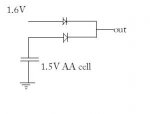I know this isnt directly related to PICAXE but im not sure where else to ask such a question...
The temperature sensing module im using to feed into my 28X1 (Requires a 1.5V supply) is programable for temperature limits, which is why im using it...
However, should the mains supply that im using to power the circuit fail (power cut etc), it looses the preset temperatures...most annoying!
I want to encorporate a 1.5V battery of some description (AA makes most sence due to the LCD that also needs power).
Is there a simple circuit I can build that effectivley disconnects the battery from the circuit until the main supply cuts out so that the battery is not drained during normal "powered" opperating conditions?
Im limited to about 500 milliamps from the input powersupply max...
I had thought about using a relay that closes the connection to the battery when power is removed but I fear this would be too slow and thus, the memory would be lost..
The temperature sensing module im using to feed into my 28X1 (Requires a 1.5V supply) is programable for temperature limits, which is why im using it...
However, should the mains supply that im using to power the circuit fail (power cut etc), it looses the preset temperatures...most annoying!
I want to encorporate a 1.5V battery of some description (AA makes most sence due to the LCD that also needs power).
Is there a simple circuit I can build that effectivley disconnects the battery from the circuit until the main supply cuts out so that the battery is not drained during normal "powered" opperating conditions?
Im limited to about 500 milliamps from the input powersupply max...
I had thought about using a relay that closes the connection to the battery when power is removed but I fear this would be too slow and thus, the memory would be lost..

